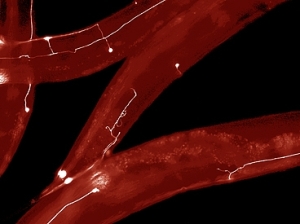Oct 12 2010
Scientists have long sought the ability to regenerate nerve cells, or neurons, which could offer a new way to treat spinal-cord damage as well as neurological diseases such as Alzheimer's or Parkinson's. Many chemicals can regenerate neurons grown in Petri dishes in the lab, but it's difficult and time-consuming to identify those chemicals that work in live animals, which is critical for developing drugs for humans.
Engineers at MIT have now used a new microchip technology to rapidly test potential drugs on tiny worms called C. elegans, which are often used in studies of the nervous system. Using the new technology, associate professor Mehmet Fatih Yanik and his colleagues rapidly performed laser surgery, delivered drugs and imaged the resulting neuron regrowth in thousands of live animals.
 MIT engineers have developed a way to rapidly perform surgery on single nerve cells in the worm C. elegans. The white lines represent axons — long extensions of nerve cells that carry messages to other cells.
MIT engineers have developed a way to rapidly perform surgery on single nerve cells in the worm C. elegans. The white lines represent axons — long extensions of nerve cells that carry messages to other cells.
"Our technology helps researchers rapidly identify promising chemicals that can then be tested in mammals and perhaps even in humans," says Yanik. Using this technique, the researchers have already identified one promising class of neuronal regenerators.
The paper will appear in the online edition of the Proceedings of the National Academy of Sciences the week of Oct. 11.
C. elegans is a useful model organism for neuron regeneration because it is optically transparent, and its entire neural network is known. Yanik and colleagues had previously developed a femtosecond laser nanosurgery technique which allowed them to cut and observe regeneration of individual axons —long extensions of neurons that send signals to neighboring cells. Their femtosecond laser nanosurgery technique uses tightly-focused infrared laser pulses that are shorter than billionth of a second. This allows the laser to penetrate deep into the animals without damaging the tissues on its way, until the laser beam hits its very final target i.e. the axon.
In the PNAS study, the researchers used their microchip technology to rapidly cut the axons of single neurons that sense touch. Moving single worms from their incubation well to an imaging microchip, immobilizing them and performing laser surgery takes only about 20 seconds, which allows thousands of surgeries to be performed in a short period of time.
After laser surgery, each worm is returned to its incubation well and treated with a different chemical compound. C. elegans neurons can partially regrow without help, which allowed Yanik's team to look for drugs that can either enhance or inhibit this regrowth. After two or three days, the researchers imaged each worm to see if the drugs had any effect.
The MIT team found that a compound called staurosporine, which inhibits certain enzymes known as PKC kinases, had the strongest inhibitory effect. In a follow-up study, they tested some compounds that activate these kinases, and found that one of them stimulated regeneration of neurons significantly. Some of Yanik's students are now testing those compounds on neurons derived from human embryonic stem cells.
This microchip technology can also be used to screen compounds for their effects on other diseases such as Alzheimer's, Parkinson's and ALS, says Yanik.
Source: http://web.mit.edu/